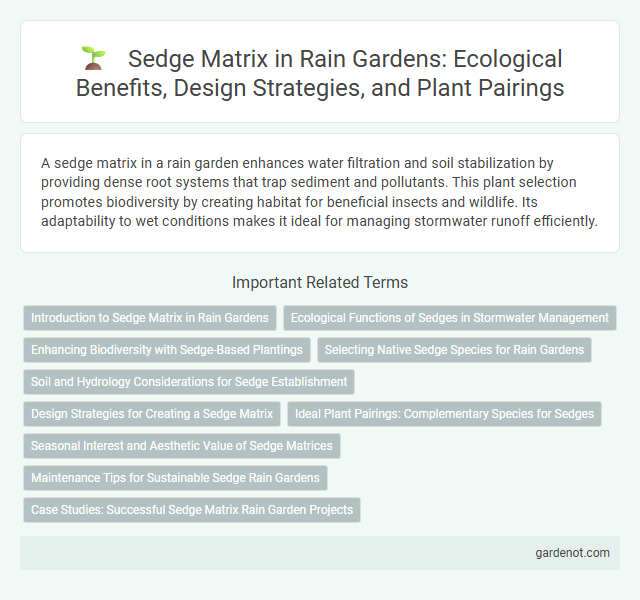A sedge matrix in a rain garden enhances water filtration and soil stabilization by providing dense root systems that trap sediment and pollutants. This plant selection promotes biodiversity by creating habitat for beneficial insects and wildlife. Its adaptability to wet conditions makes it ideal for managing stormwater runoff efficiently.
Introduction to Sedge Matrix in Rain Gardens
Sedge matrix in rain gardens serves as a dense planting technique using native sedge species to stabilize soil and enhance water filtration. This vegetation matrix improves stormwater management by increasing infiltration rates and trapping pollutants through its fibrous root systems. Incorporating a sedge matrix supports biodiversity and creates a resilient ecosystem capable of withstanding fluctuating moisture conditions.
Ecological Functions of Sedges in Stormwater Management
Sedge matrix plays a crucial role in stormwater management by enhancing water filtration and nutrient uptake, effectively reducing pollutants before they reach waterways. Their dense root systems stabilize soil, preventing erosion and promoting groundwater recharge. Sedges also provide habitat for beneficial microorganisms that further break down contaminants, contributing to improved water quality and ecosystem health.
Enhancing Biodiversity with Sedge-Based Plantings
Sedge matrix plantings play a critical role in enhancing biodiversity by providing diverse habitats and food sources for urban wildlife within rain gardens. These dense, native sedge species support a wide range of pollinators, beneficial insects, and small amphibians, contributing to ecosystem resilience and water quality improvement. Incorporating sedge matrices in rain garden designs promotes sustainable stormwater management while fostering ecological balance through increased plant and animal species richness.
Selecting Native Sedge Species for Rain Gardens
Selecting native sedge species for rain gardens enhances stormwater management by promoting deep root systems that improve soil infiltration and reduce runoff. Species like Carex stricta and Carex vulpinoidea thrive in wet conditions, supporting biodiversity and providing habitat for local wildlife. Choosing regionally adapted sedges ensures resilience to local climate variations and minimizes maintenance requirements.
Soil and Hydrology Considerations for Sedge Establishment
Sedge matrix thrives in well-drained, moist soils with consistent moisture levels that mimic natural wetland hydrology. Ideal soil conditions include loamy or silty textures with high organic content to support root development and water filtration. Maintaining hydrologic balance with periodic inundation and drying cycles enhances sedge establishment and promotes a resilient rain garden ecosystem.
Design Strategies for Creating a Sedge Matrix
Design strategies for creating a sedge matrix in rain gardens emphasize selecting a diverse range of native sedge species that thrive in varying moisture levels to enhance biodiversity and stabilize soil. Establishing dense plantings with staggered spacing promotes effective water filtration and erosion control while supporting wildlife habitats. Incorporating appropriate substrate materials, such as organic-rich soils and engineered layers, optimizes moisture retention and nutrient cycling within the sedge matrix system.
Ideal Plant Pairings: Complementary Species for Sedges
Sedge matrix thrives when paired with complementary species such as native rushes, ferns, and moisture-loving wildflowers that enhance its natural filtration properties. Ideal plant pairings include Carex species combined with Juncus effusus and Astilbe, which create a diverse habitat supporting soil stability and water absorption. These combinations optimize nutrient uptake and provide year-round visual interest in rain garden ecosystems.
Seasonal Interest and Aesthetic Value of Sedge Matrices
Sedge matrices provide year-round seasonal interest by showcasing dynamic textures and rich green hues in spring and summer, transitioning to warm bronze and gold tones during fall. Their dense, tufted foliage contrasts beautifully with flowering perennials, enhancing aesthetic value in rain gardens. The natural movement of sedges in breeze adds kinetic beauty while supporting stormwater management goals.
Maintenance Tips for Sustainable Sedge Rain Gardens
Sedge matrix in rain gardens thrives with minimal maintenance, requiring occasional weeding to prevent invasive species from overtaking the sedge. Regular inspection ensures proper water infiltration and helps identify areas where sediment buildup may impede growth. Periodic thinning supports healthy plant density, promoting sustained ecological benefits and enhancing stormwater management.
Case Studies: Successful Sedge Matrix Rain Garden Projects
Case studies of successful sedge matrix rain garden projects demonstrate effective stormwater management and enhanced biodiversity in urban landscapes. Notably, the University of Washington implemented a sedge matrix rain garden that reduced runoff by 40% while supporting native pollinators. Another example, Chicago's Lincoln Park Eco-Rain Garden, showcases improved water quality and community engagement through diverse sedge species integration.
Sedge matrix Infographic

 gardenot.com
gardenot.com